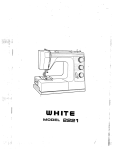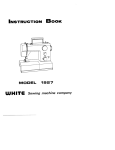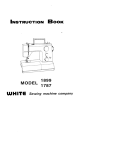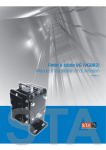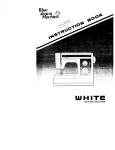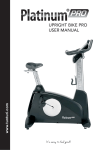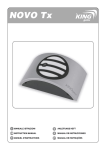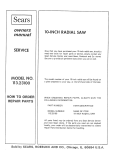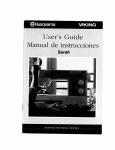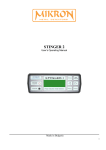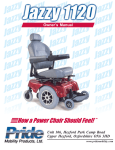Download Sharp R-1505F Specifications
Transcript
(flu’ -- m r C C 0 w0 z 0 0 -I C 0 z SEWING MACHINE Record in space provided below the Serial No. and Model No. of this appliance. The Serial No. is located Rear of arm. The Model No. is located Rear of arm. Serial No. Model No.1505, 1510 Retain these numbers for future reference. CONTENTS 1. NAMES OF PARTS 2. ACCESSORIES 3. BEFORE SEWING Detachable Extension Table Connecting Foot Controller and Power Cord Setting Spooi Pins Changing Foot Changing Needle Bobbin Winding Inserting Bobbin Adjusting Lower Tension Darning Plate Threading Upper Tension Drawing Up Lower Tension Foot Pressure Fabric, Thread and Needle Table 4. STARTING TO SEW Turning a Square Corner Pattern Selection Dial Starting to Sew Double Presser Foot Lifter Reverse Sewing Cloth Guide Adjusting Thread Tension 5. STRAIGHT SEWING 6. ZIGZAG SEWING Thread Tension for Zigzag Stitch 7. MAKING BUTTONHOLES Determine Length Left and Right Side Balance of Buttonhole Cutting Buttonholes Corded Buttonholes 8. OVERCASTING 9. BLIND HEM STITCH Elastic Blind Hem Stitch 10. SHELL STITCHING 11. MENDING Mending a Rip 12. STRETCH STITCHING Adjusting Stretch Stitch Balance 13. STRETCH SEAMS Straight Stretch Stitching Rick-Rack Stretch Stitching 14. LAPPED SEAM SEWING 15. BRIAR STRETCH 16. OVERLOCKING 17. SEWING ON BUTTONS 18. ZIPPER SEWING 19. ROLL HEMMING 20. QUILTING 21. EMBROIDERY 22. MAINTENANCE Cleaning Oiling 23. TROUBLE CHART Changing Light Bulb 1 3 4 4 5 6 7 8 9 12 13 13 14 15 15 16 17 1 7 18 19 19 19 20 20 21 21 21 22 22 24 25 25 26 27 28 29 30 30 31 31 32 32 32 33 34 34 35 36 37 38 39 40 40 41 42 43 we 1.NAMES OF PARTS 1 2 3 4 5 6 7 8 9 10 11 12 13 Thread guide for bobbin winding Pressure Regulator Take-up lever Face cover Upper thread tension dial Thread guide for upper threading Presser foot thumb screw Presser foot Free arm Shuttle cover Spooi pins Pattern selection dial Reverse sewing lever 14 Bobbin winding spindle 1 5 Bobbin winding stopper 16 Handwheel 1 7 Stop motion knob 18 Adjuster for buttonhole stitch balance and stretch stitch balance 1 9 Switch * 20 Socket 21 Thread guide for upper threading 22 Presser foot lifter 23 Thread cutter 24 Feed dog 25 Needle plate *Specifications vary from country to country. —2— * 0 C) C) z 0 0 C) Cl, m 0 CI) CI) m C, 3. BEFORE SEWING Machine is stored in flat-bed style which makes your work eas ier in ordinary sewing. Detachable Extension Table Slide table off and the mac hine is used as a free-arm model. Free-arm is convenient to sew or embroider; trousers, sleeves, cuffs of T-shirts, blouses, etc. Do vice-versa of above step s to attach extension table. To open lid of accessory box, push it open, as illustrated. —4— Connecting Foot Controller and Power Cord Connect foot power cord ED controller and . Before plugging in your machine, be sure that voltage is same as that of your machine. (written on a plate at back of machine) *Specifications vary from country to country. Switch on, put power on the machine and turn on the sewing light. Push button to turn sewing light on and off. Always switch off or unplug machine when not in use. *Specifications vary from country to country. * —5— The more you press foot controller, the faster the machine runs. Setting Spool Pins Spool Pins are packed in accessory box Screw thread spool pins in place securely with a screw driver. Place the felts as shown. —6— Changing Foot Raise presser foot lifter I D. needle in the highest Set position by turning handwheel towards you Remove foot holder by loosening screw with screwdriver. 4 Replace screw-snap type presser foot and tighten screw. 9 —7—- Changing Needle Set needle in the highest position by turning handwheel towards you. Loosen needle clamp screw and take out needle. With flat side away from you, insert a new needle into groove of needle bar. Push needle into clamp until it reaches stopper ® and tighten needle clamp screw firmly. Always use a straight needle with a sharp point. Proper needle straight shaft sharp point Using defective or worn needles not only causes stitch skipping, breakage of needles or snapping of thread; it also can damage hook and needle plate. I —8— Bobbin Winding Set needle in the highest position by turning handwheel towards you. Open shuttle cover. Open latch of bobbin case and take it out. Close latch of bobbin case and bobbin comes out easily. —9— Mount spool pin on top cover. Put a spool on spool pin. Draw thread from spool pin through thread guide and pre tension device, following numb ers D and © Wind thread clockwise around bobbin several times. Push bobbin on to spindle. Holding handwheel with your left hand disengage handwheel by unscrewing stop motion knob. ‘4 J —10— Push bobbin to right and pre ss down foot controller. Machine stops automatically when bobbin is full. Push bobbin to left, to disenga ge from wheel. Take off bobbin and cut thread. from spindle Retighten stop motion kno b. If bobbin is wound une venly as shown, open face cover and loosen set-screw of the gui de for bobbin winding: Use screw driv er to adjust height. —11— Inserting Bobbin Place bobbin in its case with thread running in direction of arrow. (clockwise> Guide thread into bobbin case. slot ® of I Pulling thread to left, bring it under tension spring then to delivery eye ®. —12— Adjusting Lower Tension To test bobbin tension, hang and shake bobbin case as shown. At proper tension bobbin case gradually drop a small will amount. To adjust tension, turn adjusting screw with small screwdriver. Raise needle position. in the highest Leave end of thread of about 1 0 cm (4”) from bobbin case. Take hold of latch and push bobbin case into hook. Release latch when bobbin case is fully inserted. ) Darning Plate There are a few times when you want to control the feeding of the fabric yourself. Raise needle to its highest position and raise presser foot. Place darning plate over needle plate aligning two pins of drning plate with holes of needle plate. You may then determine the movement of the fabric yourself. See page 39 for embroidery. —13--- j Threading Upper Thread Raise presser foot lifter. Raise take-up lever to the highest position by turning handwheel towards you. Thread following numbers D-®. Pass thread through guide D. Lead thread either side of tension disc . Hook the thread under the guide ® as shown. Thread take-up lever Pass thread to guide to left, and guide then needle eye ©. ®. ® from right ® (left one) Leave end of thread of about 15 cm (6”). —14— Drawing Up Lower Thread Hold end of upper thread with left hand. Turn handwheel slowly towards you until needle moves down and up again. Pull upper thread slowly and lower thread will be brought up in a ioop. _ Pull out both threads to about 1 5 cm (6”) and place them together under presser foot on left. Foot Pressure Push down the outer ring of the pressure regulator. This will release the pressure on the presser foot. To increase the pressure, push down inner pin until suitable pressure is obtained. Insufficient pressure may cause poor feeding of the fabric, skipped stitches, or difficulty in guiding the fabric. If feed dogs or presser foot marks appear on the fabric, reduce the pressure. When sewing multiple thickness or heavy fabric, reduce the pressure. Increase pressure when sewing lighter weight fabrics. —15— Fabric. Thread and Needle Table THREAD FABRIC NEEDLE European Mercerized [ Cotton Covered Polyester, I Silk, Nylon European U.SSize Point 705 15x1 Style Regular Cotton Cotton 70 60 Silk Nylon 65—70 9 SHEER; Blouse Crepe, Lawn, Organdy, Taffeta 50—70 60 Silk Nylon 65—70 9 LIGHT-WEIGHT; Crepe, Wool, Brocade, Velvet 30 50 Silk 75—80 1 1 MEDIUM; Wool, Silk, Linen, Velvetten, Cotton Faille, Terrycloth 30 50 Silk 80—90 11—14 HEAVY; Denim, Duck, Sailcloth 30 Heavy Duty CC.PoIy 100 16 EXTRA HEAVY; Upholstery, Canvas, Awning 30 Heavy Duty C.CPoly. 120 19 50—70 60 Silk Nylon 70 9 Light Ball MEDIUM-WEIGHT; Jersey, Double Knit, Power Net 30 50 Silk Nylon C.CPoly. 70—80 9—10 Light to Medium Ball HEAVY-WEIGHT; Double knit, Power Net 30 50 Silk Nylon C.C.PoIy. 80—90 1 1—14 Medium to Heavy Ball 30 Heavy Duty C.C.Poly. 90—100 14—16 Ball or Sharp VERY SHEER; Lace, Voile, Chiffon, Net [KNITS] LIGHT-WEIGHT; Tricot Power net FAKE-FURS, VELOURS [LEATHER] VINYLS FILMS 30 50 C.CPoly. 90 LIGHT-TO-MEDIUMWEIGHT 14 Wedge 30 50 C.C.PoIy. 90—100 14—16 Wedge HEAVY LEATHER 30 Heavy Duty C.C.Poly. 100—110 16—18 Wedge 100—110 16—18 Regular 65—80 9—11 Regular [DECORATIVE TOUCHES] TOP STITCHING Silk twist MACHINE EMBROIDERY Size 50—70 —16— REMARKS Loosen up per tension one or two points 4. STARTING TO SEW Now that you are familiar with the controls on your machine and with the accessories provided for the machine, you are ready to start to sew with your new sewing machine. Below are some good habits to follo w each time you sit down to sew: 1. Test the needle: it should be strai ght, properly set and sharp on the point. It should be the correct size for the fabric and thread being used. Do not be afraid to change your needle frequently. Many of the new fabrics made of synthetic blen ds tend to dull the needles more easily than fabrics made of natural fibers. 2. Before placing the material on the machine, see that the ends of the threads have been drawn about 6 inches to the rear of the machine. Hold on to threa ds during the sewing of the first 3 or 4 stitches of the seam. 3. Test the machine stitch on a scrap of fabric you plan to use. The fabri c should be double thickness. Adjust the machine for the length of stitch and tension suitable to your fabric. 4. Fabric should be placed under the presser foot with the bulk of the material to the left of the needle and the right edge of the material placed on the appr opriate seam marking for desired seam edge. 5. Run the machine at a slow oven speed. The more pressure you put on the foot control, the faster the machine will sew. 6. Fasten each seam by back tacki ng at the beginning and end of the seam. 7. Always finish sewing each seam with the needle at its highest point. 8. Guide the fabric gently with your hand in front of the needle. Never pull or hold the fabric in such a way that the normal feeding is altered. 9. When turning the hand whee l manually, always turn it towa rd you. Turning A Square Corner To turn a square corner 5/8 ” from the fabric edge, stop stitching with the needle tip piercing the fabric, when reaching the cornering guide as shown, Raise the presser foot, turn fabric. New stitching line will align with 5/8” seam guide on side of needle plate. Lower the presser foot and begin stitching in new direction. —17— Pattern Selection Dial The desired stitch will be obtained by turning the stitch selector, it can be turned either to the right or to the left. Note: When operating selector, make sure needle is in the highest positio n. The Stitches Are Shown as Below. rMODEL:1 51 0, 2640 S Bartack stitch of buttonhole. Left side stitch of buttonhole. 8 Right side stitch of buttonhole. 7 S traight stitch (3 kinds of stitch length) 8,9, Zigzag stitch (4 kinds of zigzag 10,1 lwidth) 12 Blind stitch. 13 Stretch blind stitch. 14 Mending stitch. 1 5 Straight stretch stitch 16 Rickrack stitch. I 1 7 Briar stretch stitch 1 8 Feather stretch stitch 1 9 Overcast stretch stitch. 5 6 (iDEL:l 505. 2440 Bartack stitch of buttonhole. j j Left side stitch of buttonhole. Right side stitch of buttonhole. 7 S traight side stitch (3 kinds of stitch length) 8,9. Zigzag stitch (3 kinds of 10 zigzag width) 11 Blind stitch. 12 Straight stretch stitch. 1 3 Overcast stretch stitch. 5 6 —18— Starting to Sew Place fabric under foot about 1 cm (0.4”) inside the edge. Lower presser foot lifter. Double Presser Foot Lifter In order open fling materials, foot lifter to obtain a larger when using very thick firmly push presser up as far as it will go. Reverse Sewing To reinforce seam, sew back wards to the edge of fabric by pushing down reverse sewing lever. Release lever and commence forward sewing guiding fabric by hand as it is fed. Never pull material. —19— Cloth Guide * Option accessory. Use cloth guide when sewing a long seam of regular distance from edge of material. Set guide in hole on arm, at right of needle plate, and adjust distance. Run machine with edge of fabric touching guide. Position cloth guide at an angle to sew a curved seam. Sew reverse stitches for rein forcement at end of seam. Draw fabric to left when sewing is finished. Cut threads with thread cutter behind presser bar. Adjusting Thread Tension Test stitch performance on a scrap of material you are going to use. With correct tension (®). upper and lower threads tension is equal and strong enough to lock both threads in center. If upper tension is too tight (loose), upper (lower) thread lies straight along upper (lower) surface of fabric (6J©). Correct by turning tension dial. 0 J[ ::i.i#1 hf © —20— 5. STRAIGHT SEWING Set machine as shown. * Option accessory. 3 kinds of straight stitch lengths can be selected as shown below. Stitch Selector No. 5 No. 6 No. 7 Stitch length 2% 3% 4% 6. ZIGZAG SEWING // Set machine as shown. To prevent seam ends unravell ing, set machine for straight stitch and sew in reverse at beginning and ending of seam. \_ 4 kinds or 3 kinds of zigzag patterns can be selected. * F No.11 for model 1 510 and 2640 only. * Thread Tension for Zigzag Stitch Stitch Selector Zigzag Width Stitch Length No. No. No. No. 2mm 3mm 4mm 5mm 1mm 2mm 3mm 4mm 8 9 10 11 ,— back side N Better-looking zigzag stitching requires less upper tension than straight stitching. Loosen upper tension slightly. —21— right side 7. MAKING BUTTONHOLES ‘F Set machine as shown. Determine Length marking 3cm(1 /8’) length of a buttonhole Measure diameter and thickness of button and add 0.3cm (1/8) for bar tacks, Mark buttonhole size on material. diameter cithickness_ J Attach buttonhole foot. Completely push back sliding part () of buttonhole foot. Place material under foot so that marking of buttonhole passes through center of foot and arrow ( of foot indicates beginning line of marking. —22— Bar tacking: Set pattern selec tion dial to 1 ( ) and sew 5-6 stitches. . Left side: Change pattern to 2 ). Sew left side from front to back until it reaches end line. , J Remember the point where arrow shows so that it is not necessary to mark end lines for all buttonholes. Bar tacking: Change pattern to 3 ) and sew 5-6 stitches. UL - I- ft Right side: Change pattern to 4 ) and sew right side until it catches first bar tack. II —23-- I Left and Right Side Balance of Buttonhole Stitch density on right and left sides of buttonhole can be adjust by buttonhole balanc e control dial. This dial should usually be in a neutral position (betwe en .‘+“ and If the stitches on the rig ht side of the buttonhole are too close together, turn the dial to the right I (+). *Turning dial to right opens right side and closes left sid e. ± J f the stitches on the rig ht side of the buttonhole are too open, turn the dial to the left (—). *Turning dial to left clo ses right side and opens left side. [ Note: This dial can simultaneously adjust stretch stitch balanc e. Therefore please refer to page 31 when you move this dial. —24— Cuttrng Buttonhol es Stick a needle throu gh bar tacks to prevent over-cu tting. Cut buttonhole along center with buttonhole cutter. Corded Buttonh oles For stretch fabrics such as knits, a corded buttonhole is effective to keep finished buttonhole in shape. Hook filler cord on top spur and lead ends of cord under foot, pull taut, and hook the m to bottom notches as shown. Proceed with sti tching as for regular buttonhole s. When buttonhole is completed, pull filler cord ends so that loop on the other end dis appears into buttonhole stitching . Thread ends of co rd to reverse side and tie, or cu t both ends of cord. —25— 0) r%) 0 0 0 :r 30 CDD 0 -.3 (1)0 CDCD . CD Cl o 0 - 01 O -e -‘ CD CO (00 P. 0 (Do — -. _e — (DO CDz -e D 000 O - 0 CD Dz P. CD 0 0o CD o (03 0 . (1)0)1 CD 0 P. T 0) z U) -1 C) 0 m 7- 9. BLIND HEM STITCH Set machine as shown. Fold material as shown and place it under foot. For a neater finish, it is preferable to baste or iron hem beforehand. mm(o.2’)_,.. 1 3—5 ’ \ fold guiding carefully, Sew against guide so that straight stitches are made on hem edge, and slanting stitches pierce only one or two threads of fold. —27— right side ® Correct seam. ® Needle is catching edge of fold wrong side too much. © Needle is not catching edge of fold at all. © Elastic Blind Hem Stitch (For model 1510 and 2640 only.) For elastic materials, set machine as shown and sew in the same way as for normal blind hem stitch. —28— 10. SHELL STITCHING Silk, nylon organdy or similar sheer fabrics are suitable. Set machine as shown. Fold edge of material. With folded edge to left, place it under presser foot. Pull thread ends towards back when starting sewing. Make sure needle misses raw edge of fold when it moves side ways. 11. MENDING I- Patching (For model 1510 and 2640 only.) Set machine as shown. J Place the patch over the worn part. Sew along the edge of the patch on the right side. Trim away the worn part close to the seam on back side. Mending a Rip 4 (For model 1 51 0 and 2640 only.) Set machine in the same way as for patching. Sew the edges of tear together first. Then sew two more seams on either side. A piece of gauze can be placed underneath to reinforce the rip. —30— 12. STRETCH STITCHING The stitches shown are all used with stretch and knit fabrics. These are special stitches built in the machine for your quick selection. ‘It 1:: Straight stretch III III IIl III III Rickrack briar stretch Briar stretch > Ill ill III III Feather stretch Overcast stretch For model 1510 and 2640 onlyj Adjusting Stretch Stitch Balance In stretch stitch sewing, the stretch stitch adjuster should usually be in a neutral position (between ‘+‘ and “—“). When sewing some fabrics, you may need to adjust this control to balance the stitches for appear ance sake. If design seems open like the illustriations to the left, adjust the control slightly toward until design looks like the center design. If the design appears to be closed as in the right hand illustrations, turn the control toward “+“until stitching is as you desire. / ± “— II —31— L 13. STRETCH SE AMS For model 1510 an d 2640 only.) Set machine as shown. * Option accessory. Straight Stretch Stitching Use this stretch stitch with knitted fabric and other fabrics that stretch. Sew as you do with regular straight stit ch seaming. The seam may be pressed open as with any regula r seam, but will stretch if nece ssary. This is also a good stitch to use on curved seams regardless of the type of fabric. An y seam that will receive a great deal of strain when worn should be sewn with the stretch stitch. Us e in children’s shorts and slacks as well as adult sports clothes. Rick-Rack Stretch Stitching (For model 1510 an d 2640 only.) Sew on stretch fab rics in any area that you might use a zigzag stitch. This stitch can be used as a decorative top stitch as well. —32--- 14.LAPPED SEAM SEWING (For model 1 510 and 2640 only.) Set machine as shown. Place one piece of fabric ove r another according to the wid th of stitch size. ® For non-fray fabrics. ® For easy to fray fabrics. Sew over folded area from right side. —33— F 15. BRIAR STRETCH (For model 1510 only.) This stitch can adecorative stitch lines and clothes and 2640 be used as on household for children. 16. OVERLOCKING Formodell5lOand264O only.) Overlocking stitches make it possible to sew and overcast seams at the same time. Set machine as shown. \- Put two pieces of cloth together with right sides facing and sew. To prevent edges from fraying, sew so that right side stitches drop outside the edge of material. In some cases stitches can be overcasting. —34— overlocking used for 17. SEWING ON BUTTON S Set machine as shown. Attach darning plate on needle plate. (See page. 13) Select Zigzag width to suite the size of the button from pat tern No. 8, 9, and 10. * No.11 for model 1510 and 2640 only. Place a button and material under foot. Sew 5-6 zigzag stitches. Stop machine when needle is in upper position. Draw out work and cut off threads. Draw thread ends throug h to wrong side and tie a knot. —35— ‘ 18. ZIPPER SEWING Set machine as shown. By using special zipper foot with sliding adjuster, zipper sewing can be easily done without turning fabric. Loosen screw ® and set foot so that needle comes into position (. Tighten screw. Sew right side of zipper guiding fabric carefully so that right side teeth of zipper are parallel with left edge of foot. Re-set foot so that needle comes into position ©. Sew left side of zipper in the same way. —36-- 19. ROLL HEMMING Set machine as shown. Option accessory. With straight stitch * Make O.3cm(1/8”) double fold for about 5cm(2”) at very edge of material, and crease it. Sew twice at O.6cm(1/4”) from edge. Draw out work and leave about 1 5cm(6”) of thread. \II Place material under presser foot and guide edge into scroll, pulling six thread ends towards back. Sew a few stitches as shown. Keep guiding material holding raw edge about O.6cm(1/4”) in front of foot. —37— 20. QUILTING Set machine as shown. * Option accessory. Baste layers of material to prevent them from slipping out as you sew. Loosen presser foot thumb screw and insert square cut of quilting guide holder between screw and foot. Tighten screw. Mark first line with pencil or tailor’s chalk, and sew. From second line, just sew, following seam of first line using guide. Interval between seams can be adjusted by moving guide in direction of arrow. 21. EMBROIDERY Set machine as shown. Remove foot, and holder screw. To avoid lower thread being pulled up, reduce upper thread tension. - For good embroidery, it is important to use correct needles and thread. Use thin embroidery silk for upper thread and a thinner silk of same kind and color for lower thread. Trace your design on material and center it in embroidery hoop. Make sure material is taut. ,— Needle - Pull out lower thread by turning handwheel towards you while holding upper thread lightly. Lower presser foot lifter. Hold both threads and start sewing along outline of design with satin stitch. Continue sewing guiding by hand. hoop To finish filling, sew several stitches with zigzag width at 0. (Pattern selector dial” No.5, 6,7) Lay typewriting paper underneath when embroidering sheer fabric. —39— Thread No. 9 120—100 No. 11 100—80 No. 14 60—-50 _/ ___ ___ ___ ___ 22. MAINTENANCE Your machine requires regular few hours a day needs to be . cleaned and oiled once a month Cleaning Remove foot and needle. Remove needle plate. feed Brush off all dust and lint on dog with cleaning brush. Turn latches outwards. Remove hook race cover. race Remove hook. Clean hook soft a and sh bru with a cleaning cloth. Oiling Use oil manufactured specially for sewing machine use. Other oils will eventually cause mechanism to jam. Apply one drop of oil to part of hook where friction occurs. Open face cover and apply oil in the same way. Be careful not to apply too much oil or it may stain your material and cause some sewing difficulty. After oiling, run machine for 1-2 minutes to allow oil to penetrate to every part. Remove top cover by loosening screws ® and ® with large screwdriver. E E Apply one drop of oil to lubricating points indicat ed by arrows. —41— 23. TROUBLE CHART PROBLEM Breaking lower thread Skipping stitches Irregular stitches The material not fed correctly PROBABLE CAUSE CORRECTION Thread not wound evenly on the bobbin or not drawn up correctly P.1 1, P.14 Lower thread tension too tight Lint stuck in the bobbin case and inside the tension spring P.13 Remove lint and fluff with a cleaning brush Needle not fully inserted P. 8 Needle bent P. 8 Size or type of needle and thread not suitable for the material P 16 Incorrect upper threading P.14 Too much oil on the hook P.41 Incorrect size of needle for the material Upper thread tension too loose P.14 P.20 Incorrect lower tension P.12 Pattern selection dial not set correctly P.18 Lint stuck on the feed dog P.40 —42— PROBABLE CAUSE PROBLEM The material puckers Upper or lower thread tension too tight Stitch too long for material P.1 3, P.20 P.18 P.16 Thread too thick Incorrect threading of upper or lower thread Breaking needle CORRECTION P.14, P.12 Needle not correctly inserted P. 8 Needle bent P. 8 Needle clamp screw too loose Upper thread tension too tight P. 8 Needle too fine for the material Dials have been changed while the needle was down in the material P.1 6 P.20 P.18 consult your nearest dealer. If trouble is still apparent in the machine, please Do not try to correct fault by yourself. Changing Light Bulb Unplug the machine. Open face cover as shown. Remove bulb by unscrewing it in counterclockwise. Install a new bulb by screwing it in clockwise. * In case face cover is fixed by a screw, open face cover after loosening a screw by screw driver. —43—. D -1 -tl • CD C.fl CD















































